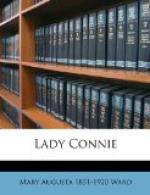“That was ages ago. He doesn’t want anybody asked now,” said Lady Laura resentfully. “He can’t understand why you want a party.”
“I thought he said something about Lady Constance Bledlow?”
“That was in June!” cried Lady Laura. “He certainly wouldn’t let me ask her, as things are.”
“Have you any idea whether he may have wanted to marry her?”
“He was very much taken with her. But how can he think about marrying, Arthur? You do say the strangest things. And after Dagnall’s behaviour too.”
“Raison de plus! That girl has money, my dear, and will have more, when the old aunts depart this life. If you want Duggy still to go into Parliament, and to be able to do anything for the younger ones, you’ll keep an eye on her.”
Lady Laura, however, was too depressed to welcome the subject. The gong rang for dinner, and as they were leaving the room, Sir Arthur said—
“There are two men coming down to-morrow to see the pictures, Laura. If I were you, I should keep out of the way.”
She gave him a startled look. But they were already on the threshold of the dining-room, where a butler and two footmen waited. The husband and wife took their places opposite each other in the stately panelled room, which contained six famous pictures. Over the mantelpiece was a half-length Gainsborough, one of the loveliest portraits in the world, a miracle of shining colour and languid grace, the almond eyes with their intensely black pupils and black eyebrows looking down, as it seemed, contemptuously upon this after generation, so incurably lacking in its own supreme refinement. Opposite Lady Laura was a full-length Van Dyck of the Genoese period, a mother in stiff brocade and ruff, with an adorable child at her knee; and behind her chair was the great Titian of the house, a man in armour, subtle and ruthless as the age which bred him, his hawk’s eye brooding on battles past, and battles to come, while behind him stretched the Venetian lagoon, covered dimly with the fleet of the great republic which had employed him. Facing the Gainsborough hung one of Cuyp’s few masterpieces—a mass of shipping on the Scheldt, with Dordrecht in the background. For play and interplay of everything that delights the eye—light and distance, transparent water, and hovering clouds, the lustrous brown of fishing boats, the beauty of patched sails and fluttering flags—for both literary and historic suggestion, Dutch art had never done better. Impressionists and post-impressionists came down occasionally to stay at Flood—for Sir Arthur liked to play Maecenas—and were allowed to deal quite frankly with the pictures, as they wandered round the room at dessert, cigarette in hand, pointing out the absurdities of the Cuyp and the Titian. Their host, who knew that he possessed in that room what the collectors of two continents desired, who felt them buzzing outside like wasps against a closed window, took a special pleasure in the scoffs of the advanced crew. They supplied an agreeable acid amid a general adulation that bored him.




